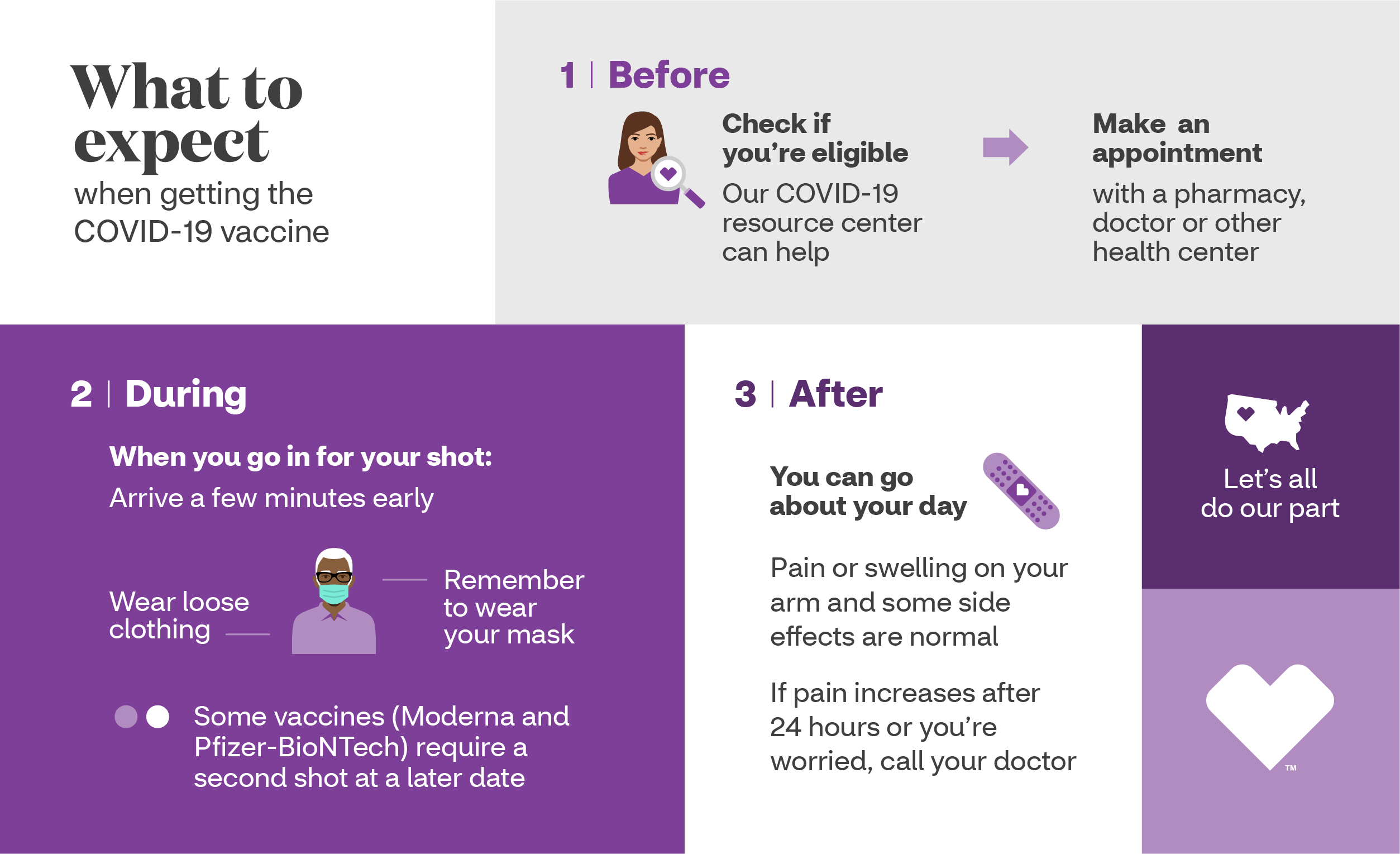Links to various Aetna Better Health and non-Aetna Better Health sites are provided for your convenience. Aetna Better Health is not responsible or liable for non-Aetna Better Health content accuracy or privacy practices of linked sites or for products or services described on these sites.
What to expect when getting the COVID-19 vaccine
 By Chris Markle
By Chris Markle

Each day, more research is being done to further our understanding of how to treat and manage COVID-19. As more people are vaccinated, we will continue to learn more about how COVID-19 vaccines work in real-world conditions.
Here’s what we do know: Three COVID-19 vaccines are currently authorized for emergency use by the U.S. Food and Drug Administration (FDA) and are very safe — the vaccines cannot and will not make you sick with COVID-19, though you may experience side effects for a short period of time. There are many benefits to getting vaccinated, so if you’re eligible, here’s what to expect:
1. Before getting the vaccine
Each state has different guidelines when it comes to vaccine eligibility, so your first step should be to check if it’s your turn to receive a vaccine. You can do this through our state resource tool located on our COVID-19 resource center.
If you’re eligible, you’ll need to schedule an appointment through the organization providing you with the vaccine. This could be your pharmacy, your doctor’s office or another health organization. Remember to stay persistent with scheduling, and if you cannot find an appointment one day, continue to check back and explore all options. Vaccine supply and availability can often update daily. Dr. Sree Chaguturu, Chief Medical Officer of CVS Caremark®, breaks down when and where you can receive the vaccine in the video below:
2. During your appointment
You don’t need to do anything to prepare for your vaccine shot. Plan to arrive a few minutes early and remember to wear a mask that covers your nose and mouth. Wear loose clothing that allows those who are administering the shot to easily access your upper arm. Stay six feet away from others while inside and waiting in lines.
After you receive your shot, you’ll be asked to wait 15 to 30 minutes to ensure you don’t have an allergic reaction. You should receive a vaccination card or printout that tells you which COVID-19 vaccine you received, the date you received it and where you received it. You should also receive a paper or electronic version of a fact sheet that tells you more about the specific COVID-19 vaccine you received. If you received the Moderna or Pfizer-BioNTech vaccine, you’ll require a second dose to get the most protection. Make sure to schedule your second dose as close to a three-week or one-month interval as possible. The recently approved Janssen (Johnson & Johnson) vaccine only requires one shot.
Reminder: Do not share a picture of your vaccine card on social media. This is to protect your private information from being stolen.
3. After your vaccination
After your shot, it’s OK to go about your day as normal. You may experience pain and swelling on the arm where you got the shot, and you may also experience body-wide side effects like fever, chills, tiredness or a headache. These side effects are normal and should go away within a few days. Side effects can be unpleasant, but remember that while vaccination may cause temporary discomfort, it is for the benefit of your long-term health and safety. It takes time for your body to react and build protection after any vaccination. You should call your doctor if the redness or tenderness where you got the shot increases after 24 hours, or if your side effects are worrying you or do not seem to be going away.
The Moderna and Pfizer-BioNTech COVID-19 vaccines require two shots for them to work. Even if you have side effects from the first shot, unless a vaccination provider or your doctor tells you not to get a second shot, you must get your final shot to be protected from COVID-19 for these two vaccines.
If you have any concerns after your vaccination, the Centers for Disease Control and Prevention (CDC) has organized information on what to expect at their COVID-19 post-vaccination page.
Finally, don’t forget to continue to wear a mask and practice social distancing, even after you receive your vaccine. Research has shown that COVID-19 vaccines that require two shots may not protect you until a week or two after your second shot. It’s critical to practice safe habits to continue to promote the safety of everyone while the vaccine is distributed.
2020 was an incredibly challenging year, so let’s stay strong in 2021. When it’s your turn, sign up to be vaccinated and do your part to keep your neighbors healthy and well. If you have any questions about the vaccines or COVID-19, you can learn more at our COVID-19 resource center.

1. Before
Check if you’re eligible
Our COVID-19 resource center can help
Make an appointment
with a pharmacy, doctor or other health center
2. During
When you go in for your shot:
Arrive a few minutes early
Wear loose clothing
Remember to wear your mask
Some vaccines (Moderna and Pfizer-BioNTech) require a second shot at a later date
3. After
You can go about your day
Pain or swelling on your arm and some side effects are normal
If pain increases after 24 hours or you’re worried, call your doctor
Let’s all do our part
About the author
Chris Markle is a writer living in Boston, MA. Passionate about access to care and patient education, he aspires to challenge and change the way the world thinks about health through his writing.
Find additional resources on the COVID-19 vaccine.